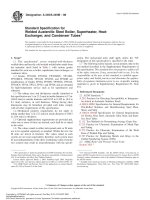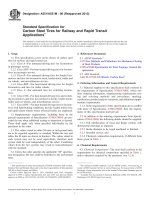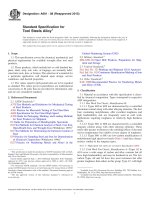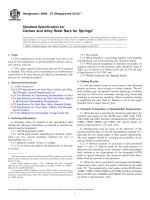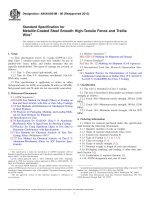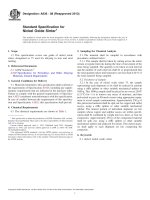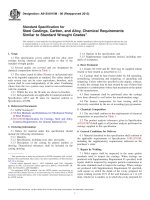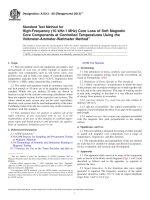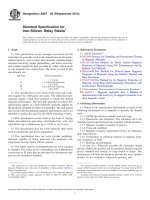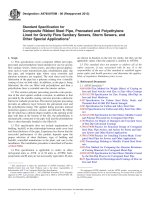Astm a 753 08 (2013)
Bạn đang xem bản rút gọn của tài liệu. Xem và tải ngay bản đầy đủ của tài liệu tại đây (99.6 KB, 6 trang )
Designation: A753 − 08 (Reapproved 2013)
Standard Specification for
Wrought Nickel-Iron Soft Magnetic Alloys (UNS K94490,
K94840, N14076, N14080)1
This standard is issued under the fixed designation A753; the number immediately following the designation indicates the year of
original adoption or, in the case of revision, the year of last revision. A number in parentheses indicates the year of last reapproval. A
superscript epsilon (´) indicates an editorial change since the last revision or reapproval.
1. Scope
A340 Terminology of Symbols and Definitions Relating to
Magnetic Testing
A341/A341M Test Method for Direct Current Magnetic
Properties of Materials Using D-C Permeameters and the
Ballistic Test Methods
A480/A480M Specification for General Requirements for
Flat-Rolled Stainless and Heat-Resisting Steel Plate,
Sheet, and Strip
A484/A484M Specification for General Requirements for
Stainless Steel Bars, Billets, and Forgings
A555/A555M Specification for General Requirements for
Stainless Steel Wire and Wire Rods
A596/A596M Test Method for Direct-Current Magnetic
Properties of Materials Using the Ballistic Method and
Ring Specimens
A772/A772M Test Method for AC Magnetic Permeability of
Materials Using Sinusoidal Current
A773/A773M Test Method for dc Magnetic Properties of
Materials Using Ring and Permeameter Procedures with
dc Electronic Hysteresigraphs
E527 Practice for Numbering Metals and Alloys in the
Unified Numbering System (UNS)
E1019 Test Methods for Determination of Carbon, Sulfur,
Nitrogen, and Oxygen in Steel, Iron, Nickel, and Cobalt
Alloys by Various Combustion and Fusion Techniques
1.1 This specification covers commonly used wrought
nickel-iron soft magnetic alloys produced or supplied expressly
for use in magnetic cores and other parts requiring high
magnetic permeability, high electrical resistivity, low coercive
field strength, and low core loss.
1.2 This specification covers materials supplied by a producer or converter to the form and physical condition desired
for fabrication into parts that will later be given a final heat
treatment to achieve the desired magnetic characteristics. It
covers materials supplied in the form of forging billet; hotrolled plate, strip, and bar; cold-finished bar; cold-rolled and
annealed sheet and strip; shaped bar and wire; and wire.
1.2.1 This specification does not cover either powder metallurgically produced or cast parts.
1.2.2 This specification lists requirements for strip products
having isotropic or semi-isotropic magnetic properties but does
not include requirements for anisotropic or square hysteresis
loop alloys or alloys processed to yield flattened hysteresis
loops by use of heat treatments in an applied magnetic field.
1.2.3 This specification does not cover alloys modified by
the addition of elements such as sulfur and selenium to enhance
machinability.
1.3 The values stated in inch-pound units are to be regarded
as standard. The values given in parentheses are mathematical
conversions to SI units that are provided for information only
and are not considered standard.
3. Terminology
3.1 The terms and symbols used in this specification are
defined in Terminology A340.
2. Referenced Documents
2.1 ASTM Standards:2
A34/A34M Practice for Sampling and Procurement Testing
of Magnetic Materials
4. Classification
4.1 Four specific alloy types are covered in Table 1.
4.2 Alloy Type 2 in thin-strip form (thickness less than or
equal to 0.020 in. (0.51 mm)) is available in two different
grades. Grade 1 is semi-isotropic and is recommended for use
in transformer laminations. Grade 2 is isotropic and is recommended for use in rotating machinery laminations and magnetic shielding parts. These grades are the result of different
mill processing (that is, cold-rolling and annealing) practices
and cannot be created by changes in the final heat treatment
given to the laminations or parts.
1
This specification is under the jurisdiction of ASTM Committee A06 on
Magnetic Properties, and is the direct responsibility of Subcommittee A06.02 on
Material Specifications.
Current edition approved May 1, 2013. Published July 2013. Originally approved
in 1978. Last previous edition approved in 2008 as A753–08. DOI: 10.1520/A075308R13.
2
For referenced ASTM standards, visit the ASTM website, www.astm.org, or
contact ASTM Customer Service at For Annual Book of ASTM
Standards volume information, refer to the standard’s Document Summary page on
the ASTM website.
Copyright © ASTM International, 100 Barr Harbor Drive, PO Box C700, West Conshohocken, PA 19428-2959. United States
1
A753 − 08 (2013)
TABLE 1 Specific Alloy Types
Alloy Type
UNS NumberA
1
2
3
4
K94490
K94840
N14076
N14080
6.2 Determination of metallic constituents and phosphorus
shall be by a method(s) acceptable to both producer and user.
Analysis of carbon and sulfur shall be done in accordance with
Test Methods E1019.
Nickel Range, %B
43.5
47.0
75.0
79.0
to
to
to
to
46.5
49.0
78.0
82.0
7. Form and Condition
A
UNS refers to the Unified Numbering System, an alloy identification system
supported by ASTM. Refer to Practice E527 for details.
B
Alloy Types 3 and 4 have additions of molybdenum, copper, and chromium to
improve magnetic performance.
7.1 These materials are capable of being produced in a wide
variety of forms and conditions suitable for further manufacture into specific magnetic articles. The desired form and
condition shall be specified and should be discussed with the
producer before ordering to assure receiving the appropriate
product. Available forms and conditions are:
7.1.1 Forging Billet— Hot worked; hot worked with surfaces prepared by grinding.
7.1.2 Hot-Rolled Plate, Strip, and Bar—Hot-rolled; hotrolled and acid cleaned; hot-rolled and annealed; hot-rolled,
annealed, and acid cleaned; hot-rolled and mechanically
cleaned; mechanical properties as specified.
7.1.3 Cold-Finished Bars—Cold-drawn; cold-drawn and
centerless ground; cold-drawn and annealed to specified mechanical properties.
7.1.4 Cold-Rolled Sheet and Strip —Cold-rolled; deep draw
quality; cold-rolled and annealed to specified mechanical
properties.
7.1.5 Wire—Cold-drawn; cold-drawn and annealed to specified mechanical properties.
7.1.6 Shaped Bar and Wire—Cold-worked; cold-worked
and annealed to specified mechanical properties.
5. Ordering Information
5.1 Orders for material conforming to this specification
shall include the following information:
5.1.1 Reference to this specification and year of issue or
revision.
5.1.2 Alloy type (Section 4) and grade where appropriate.
5.1.3 Dimensions and tolerances (Section 12).
5.1.4 Quantity (weight or number of pieces as appropriate).
5.1.5 Form and condition (Section 7).
5.1.6 Magnetic property requirements if they are other than
those listed in this specification.
5.1.7 Certification of chemical analysis and magnetic quality evaluation.
5.1.8 Marking and packaging requirements.
5.1.9 End Use—Whenever possible, the user should specify
whether the material will be machined, blanked into flat pieces,
blanked and formed, deep drawn to shape, wound into a core,
punched into laminations, or photo-etched. This will help the
producer to provide the most suitable material for the user’s
fabricating practices.
5.1.10 Exceptions to this specification or special requirements such as mechanical property requirements.
8. Magnetic Property Requirements—General
Requirements
8.1 Test Methods— Because of the extremely high magnetic
permeabilities developed in these alloys after heat treatment,
the use of permeameters (Test Method A341/A341M) is
expressly forbidden. Allowable test methods are those using
ring-type specimens.
6. Chemical Composition
8.2 Test Specimen— Whenever possible, test specimen size
and shape shall conform to those listed in Practice A34/A34M.
Specimen shapes such as stacked laminations, solid rings, and
spirally wound tape and wire cores are necessary for the most
accurate results. If, however, the product form or dimensions
precludes the use of a preferred test specimen, the specimen
shape and size shall be mutually agreed upon between the
producer and user.
6.1 The alloys shall conform to the requirements prescribed
in Table 2. Since magnetic performance is paramount, analysis
variations are permitted by mutual agreement between the user
and producer.
TABLE 2 Chemical Requirements (Weight Percent)
Carbon, max.
Manganese, max.
Silicon, max.
Phosphorus, max.
Sulfur, max.
Chromium
Nickel
Molybdenum
Cobalt, max.
Copper
IronA
Alloy 1
UNS
K94490
Alloy 2
UNS
K94840
Alloy 3
UNS
N14076
Alloy 4
UNS
N14080
0.05
0.80
0.50
0.03
0.01
0.30 max.
43.5-46.5
0.30 max
0.50
0.30 max
balance
0.05
0.80
0.50
0.03
0.01
0.30 max.
47.0-49.0
0.30 max.
0.50
0.30 max.
balance
0.05
1.5
0.50
0.02
0.01
2.0-3.0
75.0-78.0
0.50 max
0.50
4.0-6.0
balance
0.05
0.80
0.50
0.02
0.01
0.30 max.
79.0-82.0
3.5-6.0
0.50
0.30 max.
balance
8.3 Density—The assumed densities of these materials for
purposes of magnetic testing shall be as in Table 3:
8.4 Heat Treatment— The heat treatment applied to the test
specimen shall be mutually agreed upon between the producer
and user. If no such agreement exists, the heat treatment
TABLE 3 Assumed Density
Alloy Type
1
2
3
4 (4 % Mo)
4 (5 % Mo)
A
Iron is the balance by difference. Quantitative analysis of this element is not
required.
2
UNS No.
K94490
K94840
N14076
N14080
N14080
Assumed Density
(kg/m3)
g/cm3
8.17
8170
8.25
8250
8.58
8580
8.74
8740
8.77
8770
A753 − 08 (2013)
10.2 Testing shall consist of impedance permeability measured at 60Hz and shall be conducted using Test Method
A772/A772M.
applied to the test specimen shall be chosen by the producer to
exceed the magnetic property requirements listed in Tables 4
and 5 of this specification. Refer to Appendix X2 for information on heat treatment of these alloys.
10.3 The ac magnetic property requirements after appropriate heat treatment are shown in Table 5.
10.3.1 For thicknesses not listed, the requirements shall be
determined by linear interpolation of data shown in Table 5.
10.3.2 For thicknesses outside the ranges shown in Table 5,
the ac magnetic property requirements shall be as mutually
agreed between the producer and user.
9. dc Magnetic Property Requirements
9.1 dc magnetic testing shall be the only magnetic test
method used for all product forms and sizes other than thin
strip and sheet. Thin sheet and strip is defined as flat-rolled
product having a thickness of 0.020 in. (0.51 mm) or less.
9.2 Testing shall be conducted using either Test Method
A596/A596M or Test Method A773/A773M.
9.3 The dc magnetic property requirements after appropriate
heat treatment are shown in Table 4. The symbol d refers to the
minimum dimension such as thickness or diameter.
11. Typical Physical and Mechanical Properties
11.1 Typical physical and mechanical properties are listed in
Appendix X1.
12. Dimensions and Tolerances
10. ac Magnetic Property Requirements (Thin Sheet and
Strip Only)
10.1 ac magnetic testing shall be used for all strip and sheet
with a thickness of 0.020 in. (0.51 mm) or less.
12.1 Dimensions and tolerances for all product forms and
sizes shall be as mutually agreed upon between the producer
and user. In lieu of such agreement, the tolerances listed in the
latest issue of the following specifications shall apply.
TABLE 4 dc Magnetic Property Requirements
NOTE 1—The coercive field strength for Alloy Types 1 and 2 is determined from a maximum induction of 10 kG (1.0 T), while for Alloy Types 3 and
4 the coercive field strength is determined from a maximum induction of 5 kG (0.5 T).
Product Form and Size
Billet (all sizes)
Bar, Wire, Plate, Plate Coil
d > 0.500 in. (12.7 mm)
Bar, Wire, Plate, Plate Coil
d # 0.500 in.
(12.7 mm)
Sheet and Strip
0.060 # d # 0.187 in.
(1.52 # d # 4.75 mm)
Sheet and Strip
0.020 < d < 0.060 in.
(0.51 < d < 1.52 mm)
Magnetic Property
(Relative) Permeability at 40 G (14 mT), min
(Relative) Permeability at 100 G (10 mT), min
(Relative) Maximum Permeability, min
Coercive Field
Strength, Oe (A/m),
max.
(Relative)
Permeability at 40 G
(4 mT), min
(Relative)
Permeability at 100 G
(10 mT), min
(Relative) Maximum
Permeability, min
Coercive Field
Strength, Oe (A/m),
max.
(Relative)
Permeability at 40 G
(4 mT), min
(Relative)
Permeability at 100 G
(10 mT), min
(Relative) Maximum
Permeability, min
Coercive Field
Strength, Oe (A/m),
max.
(Relative)
Permeability at 40 g
(4 mT), min
(Relative)
Permeability at 100 G
(10 mT), min
(Relative) Maximum
Permeability, min
Coercive Field
Strength, Oe (A/m), max.
3
Alloy
Type 1
UNS
K94490
Alloy
Type 2
UNS
K94840
Alloy
Type 3
UNS
N14076
Alloy
Type 4
UNS
N14080
...
4500
35 000
...
6000
50 000
...
...
...
35 000
42 000
175 000
0.080
(6.4)
0.075
(6.0)
...
0.025
(2.0)
...
...
...
35 000
5000
7500
...
42 000
40 000
60 000
...
175 000
0.080
(6.4)
0.070
(5.6)
...
0.025
(2.0)
...
...
...
35 000
6000
8000
...
42 000
50 000
90 000
...
200 000
0.080
(6.4)
0.070
(5.6)
...
0.025
(2.0)
...
...
55 000
55 000
7500
9000
70 000
70 000
55 000
100 000
250 000
250 000
0.070
(5.6)
0.060
(4.8)
0.015
(1.2)
0.015
(1.2)
A753 − 08 (2013)
TABLE 5 60–Hz ac Magnetic Property Requirements
12.1.1 Bars and Billets— Specification A484/A484M.
12.1.2 Plate, Sheet, and Strip—Specification A480/A480M.
12.1.3 Wire and Wire Rod—Specification A555/A555M.
NOTE 1—Alloy Type 2 Grade 1 is not normally produced in thickness
greater than 0.014 in. (0.35 mm).
Alloy Type Thickness
and Grade in. (mm)
Type 2
UNS
K94840
Grade 1
0.014
(0.36)
0.010
(0.25)
0.006
(0.15)
Type 2
UNS
K94840
Grade 2
0.020
(0.51)
0.014
(0.36)
0.010
(0.25)
0.008
(0.20)
0.006
(0.15)
0.004
(0.010)
0.002
(0.05)
Type 4
UNS
N14080
0.020
(0.51)
0.014
(0.36)
0.010
(0.25)
0.008
(0.20)
0.006
(0.15)
0.004
(0.010)
0.003
(0.076)
0.002
(0.051)
0.001
(0.025)
Minimum (Relative) Impedance Permeability (µz)
at the Peak Flux Density of:
40 G
200 G
2000 G
4000 G
8000 G
(4 mT)
(20 mT) (200 mT) (400 mT) (800 mT)
...
...
10 500
15 000
32 000
13. Rejection and Rehearing
13.1 Material that fails to conform to the requirements of
this specification may be rejected by the user. The rejection
shall be reported to the producer promptly and in writing. The
rejected material shall be set aside, adequately protected and
correctly identified.
...
...
44 000
...
...
11 500
23 000
27 000
23 500
10 000
17 000
32 000
40 000
45 000
10 000
17 000
37 000
47 000
59 000
14. Certification
9500
16 500
39 000
51 000
66 500
8500
14 500
39 000
55 000
73 000
7000
12 000
35 000
52 000
72 000
5000
8000
26 000
41 000
58 000
14.1 When specified in the purchase order or contract, the
user shall be furnished certification that samples representing
each lot have been either tested or inspected as directed in this
specification and the requirements have been met. When
specified in the purchase order or contract, a report of the test
results shall be furnished to the user from the producer.
35 000
40 000
50 000
...
...
50 000
60 000
80 000
...
...
60 000
75 000
105 000
...
...
65 000
80 000
120 000
...
...
70 000
90 000
140 000
...
...
95 000
110 000
190 000
...
...
100 000
120 000
230 000
...
...
90 000
100 000
190 000
...
...
16. Keywords
75 000
80 000
150 000
...
...
16.1 bars; billet; nickel-iron; permeability; plates; sheets;
strips; wires
11 000
17 000
40 000
12 000
18 000
7000
13.2 The producer may make claim for a rehearing. In this
event, the user shall make samples that are representative of the
rejected material available to the producer for evaluation.
15. Packaging and Package Marking
15.1 Packaging shall be subject to agreement between the
producer and user.
15.2 Material furnished under this specification shall be
identified by the name or symbol of the producer, alloy type,
grade where appropriate, heat number, and product size. Each
heat supplied on an order must be identified and packaged
separately.
APPENDIXES
(Nonmandatory Information)
X1. TYPICAL PHYSICAL AND MECHANICAL PROPERTIES
vided for information only and are not subject to measurement
and certification on an order.
X1.1 Typical physical and mechanical properties are listed
in Tables X1.1-X1.3, respectively. These properties are pro-
4
A753 − 08 (2013)
TABLE X1.1 Typical Physical Properties of Annealed Alloy
Alloy 1
UNS
K94490
Alloy 2
UNS
K94840
Alloy 3
UNS
N14076
Alloy 4
UNS
N14080
Electrical Resistivity (µΩ-cm)
Electrical Resistivity (µΩ-mm)
55
550
49
490
56
560
60
600
Saturation Induction:
kG
(T)
16.0
1.60
16.0
1.6
7.6
0.76
7.8
0.78
Density:
(g/cm3)
(kg/m3)
8.17
8170
8.25
8250
8.58
8580
8.74-8.77
8740-8770
Curie Temperature, °C
440
450
390
390
Mean Linear Coefficient
of Expansion, µm/m/°C
20 to 100°C
20 to 500°C
20 to 1000°C
7.1
8.2
13.4
8.4
9.8
13.5
12.5
14.4
16.2
11.5
14.0
15.9
TABLE X1.2 Typical Mechanical Properties of Cold-Rolled Hard
Temper Strip
Strip Items 0.100-in. (2.54-mm) Maximum Thickness
Alloy 1
UNS
K94490
Alloy 2
UNS
K94840
Alloy 3
UNS
N14076
Alloy 4
UNS
N14080
0.2 % Offset
Yield strength:
(ksi)
(MPa)
115
793
135
931
...
...
150
1030
Ultimate tensile
strength:
(ksi)
(MPa)
120
827
140
965
...
...
160
1100
2
2
2
2
74
270
74
270
78
320
78
320
Elongation in 2 in.
or 50.8 mm (%)
Hardness (HR15N)
Hardness (HV1000)
TABLE X1.3 Typical Mechanical Properties of Mill Annealed Strip
Strip Items 0.100-in. (2.54-mm) Maximum Thickness
Alloy 1
UNS
K94490
Alloy 2
UNS
K94840
Alloy 3
UNS
N14076
Alloy 4
UNS
N14080
0.2 % offset
Yield strength:
(ksi)
(MPa)
32
220
30
210
30
210
32
220
Ultimate tensile
strength:
(ksi)
(MPa)
72
500
73
500
80
550
84
580
38
38
38
40
82
130
82
130
86
160
86
160
Elongation in 2 in.
or 50.8 mm (%)
Hardness (HR15T)
Hardness (HV1000)
5
A753 − 08 (2013)
X2. HEAT TREATMENT OF TEST SPECIMENS
X2.1 Producers usually evaluate the magnetic capability of
a test lot using a standard heat treatment practice that should be
listed on the material certification. Dry hydrogen atmospheres,
high annealing temperatures, and prolonged heating periods
are used for obtaining the best magnetic performance.
X2.2.4 Cool to room temperature at a rate as prescribed by
the producer. Close adherence to prescribed cooling rates is
particularly important when heat treating Alloy Types 3 or 4.
X2.3 This general procedure is recommended for determination of magnetic capability and can be used on a production
basis. Where applications do not require the ultimate in
magnetic performance, a less costly heat treatment practice can
be used by the user.
X2.2 The general heat treatment practice for these alloys is:
X2.2.1 Place the prepared test specimens in a sealed (leakfree) retort or equivalent;
X2.2.2 Use a circulated dry hydrogen atmosphere having an
entrance dewpoint of –60°F (–51°C) or lower and a free
oxygen content of less than 2 ppm;
X2.2.3 Heat to a temperature of 2050 to 2150°F (1120 to
1180°C) and hold for a period of 2 to 6 h. If retort construction
permits, even higher temperatures can be used; and
X2.4 To maintain proper qualification, it is recommended
that the producer and user use a common heat treatment
practice to establish the acceptance quality rating of a lot.
ASTM International takes no position respecting the validity of any patent rights asserted in connection with any item mentioned
in this standard. Users of this standard are expressly advised that determination of the validity of any such patent rights, and the risk
of infringement of such rights, are entirely their own responsibility.
This standard is subject to revision at any time by the responsible technical committee and must be reviewed every five years and
if not revised, either reapproved or withdrawn. Your comments are invited either for revision of this standard or for additional standards
and should be addressed to ASTM International Headquarters. Your comments will receive careful consideration at a meeting of the
responsible technical committee, which you may attend. If you feel that your comments have not received a fair hearing you should
make your views known to the ASTM Committee on Standards, at the address shown below.
This standard is copyrighted by ASTM International, 100 Barr Harbor Drive, PO Box C700, West Conshohocken, PA 19428-2959,
United States. Individual reprints (single or multiple copies) of this standard may be obtained by contacting ASTM at the above
address or at 610-832-9585 (phone), 610-832-9555 (fax), or (e-mail); or through the ASTM website
(www.astm.org). Permission rights to photocopy the standard may also be secured from the ASTM website (www.astm.org/
COPYRIGHT/).
6
